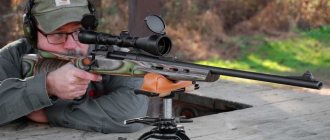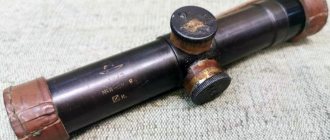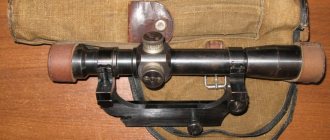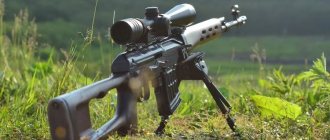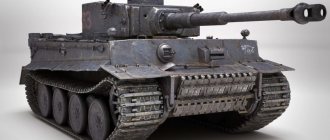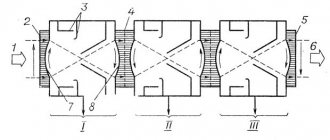Description
The PSO-1 optical sniper sight is one of the main sights of Soviet and Russian sniper weapons.
The sight was developed in 1963 specifically for the SVD rifle. A design feature of the sight was a very successful sighting reticle, allowing the sniper to quickly determine the distance and make the necessary horizontal adjustments while shooting, without rotating the flywheels. The sight is sealed, filled with nitrogen, which eliminates fogging of the optics due to temperature changes, and is equipped with a bag for carrying it on a belt, a case, filters, a power adapter, spare bulbs and a power source. Operable in the temperature range ± 50 °C. The sight, from the moment the SVD rifle was put into service, was widely used in almost all local wars and armed conflicts in the CIS, in particular during the Chechen conflict, when the concept of “sniper warfare” came into use.
Optical sight PSO-1 (military with luminescent screen) for SVD VSS AK Tiger
Optical sight PSO-1 (military with luminescent screen) for SVD VSS AK Tiger
Optical sight PSO-1 (military with luminescent screen) for SVD VSS AK Tiger
Optical sight PSO-1 (military with luminescent screen) for SVD VSS AK Tiger
Optical sight PSO-1 (military with luminescent screen) for SVD VSS AK Tiger
Optical sight PSO-1 (military with luminescent screen) for SVD VSS AK Tiger
Optical sight PSO-1 (military with luminescent screen) for SVD VSS AK Tiger
History of sights
The appearance of firearms seriously revolutionized the progress of human civilization, because they gave a serious advantage in battle. Armies possessing such power became practically invincible. It was this fact that led to the first serious and prolonged arms race. All developed countries sought to acquire more powerful and deadly weapons in order to strengthen their leadership on the world stage and strengthen their own sovereignty.
With the passage of time, not only weapons changed, but also the methods of their use. The tactics of indiscriminate shooting became less and less popular, because human resources were increasingly valued. Secretive methods of warfare came into play, implying targeted shooting from cover. For this purpose, sighting devices began to be installed on weapons. But the target range also had to be increased over time: the human eye could no longer cope with finding and holding the target.
Then, for the first time, it was decided to use a design similar in principle to telescopes. Such a device was used for the first time during the Civil War for Independence in America and firmly established itself, having received further development. Over several centuries of improvements, sights have become widely used in almost every major army in developed countries.
During the First World War, and even more widely during the Second War, sniper rifles began to be used as weapons for special infantry combat units for sabotage purposes. This battle tactic has proven itself well, but the development did not stop there.
Developments of Soviet gunsmiths
From time immemorial, Russian gunsmiths have been famous for their work. Tula masters have proven themselves especially well.
The Second World War and the subsequent increase in the pace of the arms race gave a significant impetus to the development of offensive and defensive weapons. At the same time, sniper weapons with sighting devices, which also received the necessary development, were not spared.
Thus, in 1963, the Novosibirsk Instrument-Making Plant introduced the PSO-1 optical sight. It was developed specifically for the Dragunov SVD sniper rifle, but later began to be used on other types of automatic weapons that have a special “Dovetail” side mount, which was used on weapons of the Warsaw Pact countries.
The main distinguishing feature and the main factor in the success of this device was a rather convenient sight reticle, which helps the sniper determine the distance in a short time and apply various horizontal corrections directly during shooting. At the same time, the shooter no longer needed to spend a long time adjusting the sighting device by rotating various flywheels.
Since its introduction into service, this sight has been used in almost all major local conflicts in the CIS. It was especially popular during the first and second Chechen campaigns, where the term “sniper warfare” first appeared. Human lives were at stake, so countering enemy snipers had to be effective in any conditions. The device coped with the task and is in service with the Russian army to this day, having undergone minor design changes.
There have also been many modifications based on the PSO-1, which are used by special forces. The PSO-1 optical sniper sight is used to fire at camouflaged, small-sized targets. Illuminated reticle makes it easier to aim and fire in twilight and low visibility conditions. The device helps to make corrections for wind, movement and target range. It is installed on rifles SVU, OSV-96, special types of weapons VSS, VSK-94, VAL assault rifles, as well as machine guns and Kalashnikov assault rifles.
Purpose of the PSO-1 optical sight
The PSO-1 optical sniper sight is designed for shooting at small-sized and well-camouflaged targets. Installed on a standard dovetail mount for Warsaw Pact countries. Illuminated reticle allows for aiming at dusk. The sight is equipped with rangefinder reticles, allowing for an approximate assessment of the distance to the target. The sight has the ability to enter aiming angles depending on the distance to the target and lateral corrections (for wind, target movement).
The sight can be installed on the following weapon models:
- sniper rifles: SVD (SVDS), SVU, OSV-96, TKB-0145K and others, with side mounting;
- special rifles: VSS, VSK-94 (modification PSO-1-1 with markings for a special cartridge is used);
- training rifles: TSV-1;
- special machines: “Val” 9A-91, etc.;
- carbines: “Saiga”, “Tiger”, “Sable”;
- Kalashnikov assault rifles of various modifications (with side mounting);
- Kalashnikov machine guns of various modifications, etc.
Interesting facts Edit
- 1.0004 There is a bug where you can “eat” it. To do this, you need to have three sights in your backpack, then install one of them on the weapon, throw out the remaining two and disconnect the sight on the weapon. After it appears in the inventory, double-click on it. Result: the sight has disappeared somewhere, and the sound of using ordinary inventory items (food, first aid kits, drinks) is made.
- Presumably, the PO already includes another sight - “ PSO-1m
” and its magnification -
5
. - In reality, this optical sight cannot be installed on the OTs-14 “Groza”, since there is a separate PO 4x34 sight for it.
- In reality, the sight can be installed on various weapons: SVDm-2, SVUmk-2, Vintar-VS, SA AVALANCHE, Kalashnikov assault rifles of various modifications (if there is a dovetail-type side mount).
- If you throw the scope out of your inventory and start shooting at it, it will remain completely intact. This is explained by the fact that sights, silencers and grenade launchers do not have the durability of weapons.
- It is not entirely clear why the lens of the sight is blue on the icon in the PO. Perhaps in this way the developers wanted to remove confusion between 3 other sight options (PSU-1, PSS-2x, NSPU-3).
Modifications of the PSO-1 optical sight
Difference between PSO-1 and PSO-1S-1 sighting reticles
Today there are the following modifications of the PSO sight:
PSO-1 military sights
- PSO-1 with a luminescent screen (and, accordingly, a switch) designed to detect targets manifested by infrared radiation. Illumination of the aiming reticle from a microlamp (power source 2РЦ63);
- PSO-1S without a luminescent screen with a first-generation LED and, accordingly, a 3V voltage converter;
- PSO-1M2 for targeted shooting from the Dragunov SVD sniper rifle of 7.62 caliber. Sighting scales are designed for shooting from 100 m to 1300 m. Without fluorescent screen, with 1.5 V LED and 1.5 V source;
- PSO-1M2-01 - for targeted shooting from a special sniper rifle (rifled) VSS of 9 mm caliber and a special automatic machine AC of 9 mm caliber. The sighting scales are designed for shooting from 100 m to 400 meters (50 meter increments). For shooting at dusk, the scopes have an illuminated reticle. Currently, a standard AA battery is used as a power source instead of a 2РЦ63 battery.
PSO-1 civilian sights
The civilian equivalent is the POSP sights produced by BelOMO and the PO series produced by the Oil Refinery:
- PSO-1M2-02 - modification for weapons of 12.7×107 mm caliber (limited use);
- POSP 4×24 is a modification of the PSO-1 optical sight. There is no luminescent screen or (in comparison with PSO-1M2) a built-in light filter, different markings, on the POSP 4×42T model the grid is similar to PSO-M2-01;
- POSP 6x24 - larger, 6x magnification;
- POSP 6×42 - model with 6× magnification and higher aperture;
- POSP 8x42 - the main difference from the base model is twice the apparent magnification, which corresponds to the magnification of binoculars. Compared to the original PSO-1 sample, the POSP sight has the ability to dioptrically adjust the eyepiece (POSP 8×42D) and increase the magnification (POSP 4-8×42, POSP 4-8×42D and POSP 3-9×42). In addition to this, the vertical adjustment dial on the main part of the POSP sight does not have a scale with distances as it was in the basic version, but simply has a linear digitization of “clicks” with a value of 2.5 cm per 100 meters of distance. This difference allows the sight to be used for any ammunition.
Notes
- ↑ 1 2 3 4 Potapov, A.A.
The art of the sniper. - Fair Press, 2005. - P. 404. - ISBN 5-8183-0360-8, 5-8183-0872-3. - Army sniper scopes (undefined)
. Tools of Death.ru. Access date: March 4, 2010. - Sniper war in Chechnya // Bratishka: Monthly magazine of special forces. — M.: LLC “Vityaz-Bratishka”.
- Brief description and operating instructions for the PSO-1 sniper optical sight
- Sniper training. PSO-1 sight - Law-Grif.ru
- Novosibirsk Instrument-Making Plant - optical sniper sight PSO-1M2
- Novosibirsk Instrument-Making Plant, Federal State Unitary Enterprise PA
- Safety Club “Zashchita” - performance characteristics of surveillance devices (doc)
(inaccessible link) - New generation POSP sights Caliber. RU No. 4, 2005
- Sight POSP 4x24M on the website (unspecified)
(inaccessible link). Access date: May 2, 2010. Archived February 28, 2009. - DRAGUNOV OPTICS APPLICATIONS Archived copy dated February 8, 2013 on the Wayback Machine (English)
- Note to special forces: “Gentleman’s kit” for a sniper” // Bratishka: Monthly magazine of special forces units. - M.: Vityaz-Bratishka LLC, 2006. - No. 10.
Sight device
PSO-1 device:
1-eyecup; 2-eyepiece; 3-screws; 4-flywheels; 5-body with mounting bracket; 6-lens; 7-backlight switch; 8-clamp screw; 9-adjusting nut; 10-clamp; 11-power compartment cover
The optical sight consists of a mechanical
and
optical
parts.
Mechanical part
The mechanical part of the sight includes:
- frame;
- top and side handwheels;
- sight reticle lighting device;
- retractable lens hood;
- rubber eyecup and cap.
Frame
serves to connect all parts of the sight on the rifle. The bracket has grooves, a stop, a clamping screw, a clamping screw handle, a slider with a spring and an adjusting nut. Pointers (indices) for sight settings and lateral corrections and a lens cap are attached to the body.
View through the PSO-1 sight mounted on the SVD rifle. Upper handwheel
serves to install the sight,
the side handwheel
is used to introduce lateral corrections. They are identical in design and have a handwheel housing, a spring washer, an end nut and a connecting (central) screw. There are three holes on top of each handwheel: the middle one is for the connecting screw, the two outer ones are for the locking screws.
The spring washer serves to hold the handwheel in position.
Mesh lighting device
serves to illuminate the sight reticle when shooting at dusk and at night. It consists of: a housing with a contact screw, a battery that serves as a current source, a cap with a stop and a spring for pressing the battery to the screw, wires connecting the screw (battery) to the light bulb through a toggle switch, a toggle switch for turning the light bulb on and off.
The battery is installed in the case so that the central electrode is connected to the screw, and the side electrode (displaced to the side) is connected to the case; To do this, the contact plate of the side electrode is bent over the edge of the housing, after which the cap is put on.
Eyecup
(rubber) is designed for correct installation of the eye and ease of aiming. In addition, it protects the eyepiece lenses from contamination and damage and prevents the appearance of light glare from the eyepiece lens, which illuminates the visual field and tires the shooter’s vision.
Retractable hood
serves to protect the objective lenses in inclement weather from rain, snow, as well as from direct sunlight when shooting against the sun, thereby eliminating reflections that unmask the sniper.
Rubber cap
Protects lens lenses from contamination and damage.
Optical part
PSO-1 sighting reticle
The optical part of the sight includes:
- lens;
- wrapping system;
- sight reticle;
- fluorescent screen;
- eyepiece.
Lens
serves to obtain a reduced and inverted image of the observed object. It consists of three lenses, two of which are glued.
Wrapping system
designed to give the image a normal (straight) position; it consists of four lenses glued in pairs.
Sight reticle
serves for aiming; it is made on glass mounted in a movable frame (carriage).
The following are marked on the sight reticle:
- main (upper) square for aiming when shooting up to 1000 m;
- lateral correction scale;
- additional squares (below the lateral correction scale along the vertical line) for aiming when shooting at 1100, 1200 and 1300 m;
- rangefinder scale (solid horizontal and curved dotted lines).
Fluorescent screen
serves to detect infrared light sources; it is a thin plate of a special chemical composition, which is laid between two glasses. The screen has a window with a light filter in the frame for charging the screen and a flag for switching the screen: towards the light filter (horizontal position of the flag) - for recharging the screen and when shooting under normal conditions; towards the lens (vertical position of the flag) - when observing and shooting at targets that detect themselves by infrared radiation.
Eyepiece
designed to view the observed object in an enlarged and direct image; it consists of three lenses, two of which are glued.
Using the scope
Mounting the sight
To install the sight on a weapon, you need to install the sight on the seat and move the clamping screw handle
.
On SVD-type rifles, after installing the PSO-1 optical sight, it remains possible to use a mechanical sight
, since the sight, when installed on the mount, is shifted to the left and does not overlap the mechanical sight.
Removing the sight
The PSO-1 sight can be removed from the rifle and attached to it without reducing the quality of shooting. the handle of the clamping screw towards you.
and remove the sight from the dovetail towards the butt.
Determining the range to the target
The PSO-1 optical sniper sight has a distance determination scale tied to the average human height of 170 cm.
According to the rangefinder scale
The distance to an object can be determined using a rangefinder scale. The rangefinder scale shows marks from 10 to 2. By aiming the sight so that the object is placed between the upper line of the mark and the lower horizontal line, you can determine the range to the target. In the picture on the right, for example, the range to target D
=400 meters.
On the scale of lateral corrections and angular values using the thousandth formula
Example
: We observe the chest target.
Target size B
= 0.5 m, angle
Y
= 0-01 = 1. To calculate range
D
, target size
B
is multiplied by 1000 and divided by the angle in thousandths
Y
:
D=(0.5×1000)/1=500
Content
- 1 Purpose of the sight
- 2 Sight characteristics 2.1 Sight characteristics
- 2.2 Dimensions
- 2.3 Weight
- 3.1 Mechanical part
- 4.1 Mounting the sight
- 6.1 Military
- 7.1 Advantages
Spare parts and accessories
Spare parts, tools and accessories for the optical sight are: spare batteries and light bulbs, a light filter, a screwdriver key for screwing in and unscrewing light bulbs, a napkin, a rubber cap for the toggle switch, a cover for the optical sight, a bag with a winter reticle lighting device. A filter is placed on the eyepiece when there is haze in the air and the light level decreases. The cover for the optical sight is used to protect the sight from rain, snow and dust when it is placed on the rifle.
Spare parts
Kit for upgrading the power supply for the PSO-1 optical sight - 2500 rubles. Adapter for AA battery - 2000 RUR LED AGI-18M - 1000 RUR Eyecup PSO-1 - 500 RUR Lens cap PSO-1 - 500 RUR Power compartment cover PSO-1 - 1500 RUR Illumination switch cap PSO-1 - 400 RUR Optical sight cover PSO-1 (used) - 600 rub.
